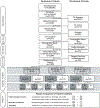The relative contributions of biomarkers, disease modifying treatment, and dementia severity to Alzheimer's stigma: A vignette-based experiment
- PMID: 34883313
- PMCID: PMC8748419
- DOI: 10.1016/j.socscimed.2021.114620
The relative contributions of biomarkers, disease modifying treatment, and dementia severity to Alzheimer's stigma: A vignette-based experiment
Abstract
Objective: The symptoms and prognosis of Alzheimer's disease (AD) dementia contribute to the public's negative reactions toward individuals with AD dementia and their families. But what if, using AD biomarker tests, diagnosis was made before the onset of dementia, and a disease-modifying treatment was available? This study tests the hypotheses that a "preclinical" diagnosis of AD and treatment that improves prognosis will mitigate stigmatizing reactions.
Methods: A sample of U.S. adults were randomized to receive one vignette created by a 3 × 2 × 2 vignette-based experiment that described a person with varied clinical symptom severity (Clinical Dementia Rating stages 0 (no dementia), 1 (mild), or 2 (moderate)), AD biomarker test results (positive vs negative), and disease-modifying treatment (available vs not available). Between-group comparisons were conducted of scores on the Modified Family Stigma in Alzheimer's Disease Scale (FS-ADS).
Results: The sample of 1,817 adults had a mean age two years younger than that of U.S. adults but was otherwise similar to the general adult population. The response rate was 63% and the completion rate was 96%. In comparisons of randomized groups, mild and moderate symptoms of dementia evoked stronger reactions on all FS-ADS domains compared to no dementia (all p < 0.001). A positive biomarker test result evoked stronger reactions on all but one FS-ADS domain (negative aesthetic attributions) compared to a negative biomarker result (all p < 0.001). Disease-modifying treatment had no measurable influence on stigma (all p > 0.05).
Conclusions: The stigmas of dementia spill over into preclinical AD, and availability of treatment does not alter that stigma. Translation of the preclinical AD construct from research into practice will require interventions that mitigate AD stigma to preserve the dignity and identity of individuals living with AD.
Keywords: Alzheimer's biomarkers; Preclinical Alzheimer's; Stigma; Treatment.
Copyright © 2021 Elsevier Ltd. All rights reserved.
Conflict of interest statement
Conflicts
The authors have no conflicts to disclose.
Figures


Similar articles
-
A survey study of Alzheimer's stigma among Black adults: intersectionality of Black identity and biomarker diagnosis.Ethn Health. 2024 Nov;29(8):946-962. doi: 10.1080/13557858.2024.2385110. Epub 2024 Jul 30. Ethn Health. 2024. PMID: 39079935
-
Double-Edged Sword: A Positive Brain Scan Result Heightens Confidence in an Alzheimer's Diagnosis But Also Leads to Higher Stigma Among Older Adults in a Vignette-Based Experiment.J Gerontol B Psychol Sci Soc Sci. 2024 Aug 1;79(8):gbae109. doi: 10.1093/geronb/gbae109. J Gerontol B Psychol Sci Soc Sci. 2024. PMID: 38869988 Free PMC article.
-
The relative contributions of disease label and disease prognosis to Alzheimer's stigma: A vignette-based experiment.Soc Sci Med. 2015 Oct;143:117-27. doi: 10.1016/j.socscimed.2015.08.031. Epub 2015 Aug 18. Soc Sci Med. 2015. PMID: 26356823
-
NIA-AA Research Framework: Toward a biological definition of Alzheimer's disease.Alzheimers Dement. 2018 Apr;14(4):535-562. doi: 10.1016/j.jalz.2018.02.018. Alzheimers Dement. 2018. PMID: 29653606 Free PMC article. Review.
-
[The controversy over early diagnosis of Alzheimer's disease: A literature review of the advantages and disadvantages].Z Evid Fortbild Qual Gesundhwes. 2023 Jun;179:95-105. doi: 10.1016/j.zefq.2023.04.004. Epub 2023 May 30. Z Evid Fortbild Qual Gesundhwes. 2023. PMID: 37263875 Review. German.
Cited by
-
Alzheimer disease blood biomarkers: considerations for population-level use.Nat Rev Neurol. 2024 Aug;20(8):495-504. doi: 10.1038/s41582-024-00989-1. Epub 2024 Jun 11. Nat Rev Neurol. 2024. PMID: 38862788 Free PMC article. Review.
-
Reasons for undergoing amyloid imaging among diverse enrollees in the A4 study.Alzheimers Dement. 2024 Sep;20(9):6060-6069. doi: 10.1002/alz.14077. Epub 2024 Jul 23. Alzheimers Dement. 2024. PMID: 39041310 Free PMC article.
-
Preclinical Alzheimer Disease and the Electronic Health Record: Balancing Confidentiality and Care.Neurology. 2022 Nov 29;99(22):987-994. doi: 10.1212/WNL.0000000000201347. Epub 2022 Sep 30. Neurology. 2022. PMID: 36180237 Free PMC article.
-
Moving beyond disclosure: Stages of care in preclinical Alzheimer's disease biomarker testing.Alzheimers Dement. 2022 Oct;18(10):1969-1979. doi: 10.1002/alz.12620. Epub 2022 Feb 25. Alzheimers Dement. 2022. PMID: 35213786 Free PMC article.
-
A survey study of Alzheimer's stigma among Black adults: intersectionality of Black identity and biomarker diagnosis.Ethn Health. 2024 Nov;29(8):946-962. doi: 10.1080/13557858.2024.2385110. Epub 2024 Jul 30. Ethn Health. 2024. PMID: 39079935
References
-
- Alzheimer’s Association National Plan Milestone Workgroup, Fargo KN, Aisen P, Albert M, Au R, Corrada MM, DeKosky S, Drachman D, Fillit H, Gitlin L, Haas M, Herrup K, Kawas C, Khachaturian AS, Khachaturian ZS, Klunk W, Knopman D, Kukull WA, Lamb B, Logsdon RG, Maruff P, Mesulam M, Mobley W, Mohs R, Morgan D, Nixon RA, Paul S, Petersen R, Plassman B, Potter W, Reiman E, Reisberg B, Sano M, Schindler R, Schneider LS, Snyder PJ, Sperling RA, Yaffe K, Bain LJ, Thies WH, Carrillo MC, 2014. 2014 Report on the Milestones for the US National Plan to Address Alzheimer’s Disease. Alzheimers Dement 10, S430–452. 10.1016/j.jalz.2014.08.103 - DOI - PubMed
-
- Alzheimer’s vaccine shows promise in Phase II trial, n.d.. European Pharmaceutical Review. URL https://www.europeanpharmaceuticalreview.com/news/156676/alzheimers-vacc... (accessed 10.29.21).
-
- American Community Survey (ACS) [WWW Document], n.d. The United States Census Bureau. URL https://www.census.gov/programs-surveys/acs (accessed 4.28.20).
Publication types
MeSH terms
Substances
Grants and funding
LinkOut - more resources
Full Text Sources
Medical

